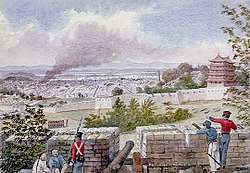Opium Wars

The Opium Wars were two wars in the mid-19th century involving China and the British Empire over the British trade of opium and China's sovereignty. The clashes included the First Opium War (1839–1842) and the Second Opium War (1856–1860). The wars and events between them weakened the Qing dynasty and forced China to trade with the other parts of the world.[1][2] The victorious British were successful in inducing an opioid crisis in China, which seriously undermined Chinese society.
In 1820, China's economy was the largest in the world, according to British economist Angus Maddison.[3] Within a decade after the end of the Second Opium War, China's share of global GDP had fallen by half.[4] In another research paper published by Michael Cemblast of JP Morgan and updated by the World Economic Forum, similar conclusions were reached—i.e. China was the largest economy in the world for many centuries until the Opium Wars.[3] In China, the period between 1839 and 1949 is referred to as the Century of Humiliation.
First Opium War
The First Opium War, fought over opium trade,[4] financial reparations,[5] and diplomatic status,[6] began in 1839 and was concluded by the Treaty of Nanking (Nanjing) in 1842. The treaty ceded the Hong Kong island to the United Kingdom in perpetuity, and it established five treaty ports at Shanghai, Canton, Ningpo (Ningbo), Foochow (Fuzhou), and Amoy. Another treaty the next year gave most favored nation status to the United Kingdom and added provisions for British extraterritoriality. Then France secured concessions on the same terms as the British, in treaties of 1843 and 1844.
In the late 18th century, the British East India Company started smuggling opium from India into China through various means and became the leading suppliers by 1773.[7] By 1787, the British were sending 4,000 chests - one chest weighed 170 lbs - of opium to China.[8] The Chinese Emperor passed many decrees/edicts against opium in 1729, 1799, 1814 and 1831, but the trade flourished.[9] Even some Americans entered the trade by bringing opium from Turkey into China. Some of the American opium traders included the great-grandfather of US President Franklin D. Roosevelt and ancestors of US Secretary of State John Forbes Kerry.[10] By 1833, the number of chests of opium trafficked into China soared to 30,000.[8] According to United Nations Office on Drugs and Crime, the British sent the opium to their warehouses in the free trade region of Canton (Guangzhou), from where Chinese smugglers would take the opium into mainland China.[9] The opium trade resulted in 4-12 million Chinese addicts and devastated especially the large coastal Chinese cities.[8] In 1839, after having a letter to the queen of England, pleading for a halt to the import of opium ignored, the emperor issued an edict ordering the seizure of all the opium in Canton, including that held by foreign governments. British traders alone lost 20,000 chests (1,300 metric tons) of opium, without compensation.[9]
Second Opium War

During 1856–1860, British forces fought towards legalisation of the opium trade, to expand coolie trade, to open all of China to British merchants, and to exempt foreign imports from internal transit duties. France joined the British. The war is also known as the "Arrow War", referring to the name of a vessel at the starting point of the conflict. The war resulted in the second group of treaty ports being set up; eventually, more than 80 treaty ports were established in China, involving many foreign powers. All foreign traders gained rights to travel within China.
References
- ↑ Taylor Wallbank; Bailkey; Jewsbury; Lewis; Hackett (1992). "A Short History of the Opium Wars (from: Civilizations Past And Present, Chapter 29: South And East Asia, 1815–1914)".
- ↑ Kenneth Pletcher. "Chinese history: Opium Wars". Encyclopædia Britannica Online.
- ↑ https://www.weforum.org/agenda/2017/09/over-2000-years-of-economic-history-in-one-chart
- ↑ Amar., Farooqui, (2005). Smuggling as subversion : colonialism, Indian merchants, and the politics of opium, 1790-1843. Lanham, Md.: Lexington Books. ISBN 0739108867. OCLC 57286105.
- ↑ Teng, Ssu-Yu; Collis, Maurice; Pelcovits, Nathan A. (August 1948). "Foreign Mud; Being an Account of the Opium Imbroglio at Canton in the 1830's and the Anglo-Chinese war that Followed". The Far Eastern Quarterly. 7 (4): 435. doi:10.2307/2049731. ISSN 0363-6917.
- ↑ Treaty of Nanking - Nanking, August 29, 1842 - Peace Treaty between the Queen of the United Kingdom of Great Britain and Ireland and the Emperor of China - Ratifications exchanged at Hongkong, 26th June 1843.
- ↑ "Opium trade - History & Facts". Encyclopedia Britannica. Retrieved 2018-07-03.
- 1 2 3 Hanes III, William Travis; Sanello, Frank (2004). The Opium Wars: The Addiction of One Empire and the Corruption of Another. United States: Sourcebooks. pp. 21, 24, 25. ISBN 1402201494.
- 1 2 3 "A Century of International Drug Control" (PDF). UNODC.org.
- ↑ Meyer, Karl E. "The Opium War's Secret History". Retrieved 2018-07-03.
External links
- "The Opium Wars", BBC Radio 4 discussion with Yangwen Zheng, Lars Laamann, and Xun Zhou (In Our Time, April 12, 2007)